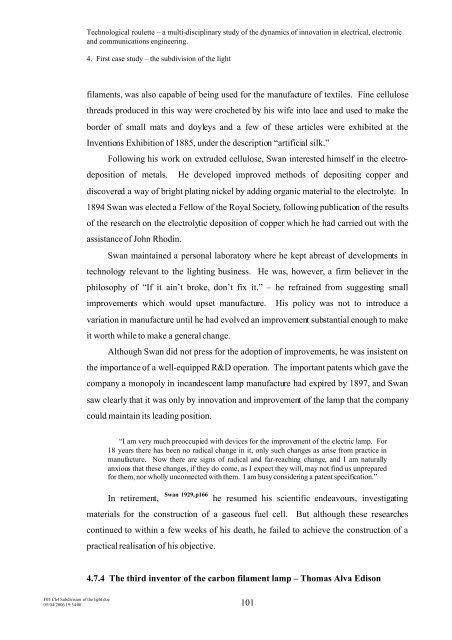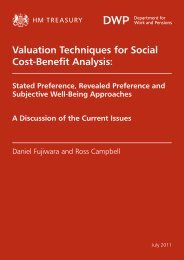4. First case study – the subdivision of the light - HM Treasury
4. First case study – the subdivision of the light - HM Treasury
4. First case study – the subdivision of the light - HM Treasury
Create successful ePaper yourself
Turn your PDF publications into a flip-book with our unique Google optimized e-Paper software.
F05 Ch4 Subdivision <strong>of</strong> <strong>the</strong> <strong>light</strong>.doc<br />
05/04/2006 19:34:00<br />
Technological roulette <strong>–</strong> a multi-disciplinary <strong>study</strong> <strong>of</strong> <strong>the</strong> dynamics <strong>of</strong> innovation in electrical, electronic<br />
and communications engineering.<br />
<strong>4.</strong> <strong>First</strong> <strong>case</strong> <strong>study</strong> <strong>–</strong> <strong>the</strong> <strong>subdivision</strong> <strong>of</strong> <strong>the</strong> <strong>light</strong><br />
filaments, was also capable <strong>of</strong> being used for <strong>the</strong> manufacture <strong>of</strong> textiles. Fine cellulose<br />
threads produced in this way were crocheted by his wife into lace and used to make <strong>the</strong><br />
border <strong>of</strong> small mats and doyleys and a few <strong>of</strong> <strong>the</strong>se articles were exhibited at <strong>the</strong><br />
Inventions Exhibition <strong>of</strong> 1885, under <strong>the</strong> description “artificial silk.”<br />
Following his work on extruded cellulose, Swan interested himself in <strong>the</strong> electro-<br />
deposition <strong>of</strong> metals. He developed improved methods <strong>of</strong> depositing copper and<br />
discovered a way <strong>of</strong> bright plating nickel by adding organic material to <strong>the</strong> electrolyte. In<br />
1894 Swan was elected a Fellow <strong>of</strong> <strong>the</strong> Royal Society, following publication <strong>of</strong> <strong>the</strong> results<br />
<strong>of</strong> <strong>the</strong> research on <strong>the</strong> electrolytic deposition <strong>of</strong> copper which he had carried out with <strong>the</strong><br />
assistance <strong>of</strong> John Rhodin.<br />
Swan maintained a personal laboratory where he kept abreast <strong>of</strong> developments in<br />
technology relevant to <strong>the</strong> <strong>light</strong>ing business. He was, however, a firm believer in <strong>the</strong><br />
philosophy <strong>of</strong> “If it ain’t broke, don’t fix it.” <strong>–</strong> he refrained from suggesting small<br />
improvements which would upset manufacture. His policy was not to introduce a<br />
variation in manufacture until he had evolved an improvement substantial enough to make<br />
it worth while to make a general change.<br />
Although Swan did not press for <strong>the</strong> adoption <strong>of</strong> improvements, he was insistent on<br />
<strong>the</strong> importance <strong>of</strong> a well-equipped R&D operation. The important patents which gave <strong>the</strong><br />
company a monopoly in incandescent lamp manufacture had expired by 1897, and Swan<br />
saw clearly that it was only by innovation and improvement <strong>of</strong> <strong>the</strong> lamp that <strong>the</strong> company<br />
could maintain its leading position.<br />
“I am very much preoccupied with devices for <strong>the</strong> improvement <strong>of</strong> <strong>the</strong> electric lamp. For<br />
18 years <strong>the</strong>re has been no radical change in it, only such changes as arise from practice in<br />
manufacture. Now <strong>the</strong>re are signs <strong>of</strong> radical and far-reaching change, and I am naturally<br />
anxious that <strong>the</strong>se changes, if <strong>the</strong>y do come, as I expect <strong>the</strong>y will, may not find us unprepared<br />
for <strong>the</strong>m, nor wholly unconnected with <strong>the</strong>m. I am busy considering a patent specification.”<br />
In retirement, Swan 1929,p166 he resumed his scientific endeavours, investigating<br />
materials for <strong>the</strong> construction <strong>of</strong> a gaseous fuel cell. But although <strong>the</strong>se researches<br />
continued to within a few weeks <strong>of</strong> his death, he failed to achieve <strong>the</strong> construction <strong>of</strong> a<br />
practical realisation <strong>of</strong> his objective.<br />
<strong>4.</strong>7.4 The third inventor <strong>of</strong> <strong>the</strong> carbon filament lamp <strong>–</strong> Thomas Alva Edison<br />
101





![AIRTO [Professor Dr Brian Blunden] - HM Treasury](https://img.yumpu.com/15492848/1/184x260/airto-professor-dr-brian-blunden-hm-treasury.jpg?quality=85)










